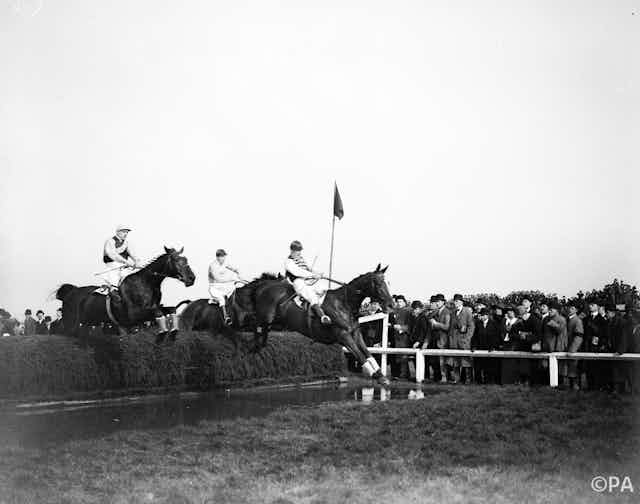On Saturday April 8, British bookmakers will see one of their busiest days of the year – and many people will make their first bet. By the late afternoon, pubs will be overflowing, sweepstakes organised, and at 5.15pm, 40 horses will begin to gallop full pelt towards a series of 30 daunting fences. Each year many fall, and dozens of horses have died. This is the Grand National, the UK’s consummate horse race, now watched by at least 8.5m people in the UK and an estimated 600m people worldwide.
Since the Grand National’s official starting date in 1839, the course has seen plenty of drama: the triple triumphs of Red Rum in the 70s; Devon Loch’s unexplained collapse at the run-in to a victory for the Queen Mother in 1956; and the mass evacuation occasioned by two coded IRA bomb threats in 1997. But then horse racing has always been this dramatic, if not more-so, and the sport played a central role in British society as it developed throughout the 18th and 19th centuries. As depicted by William Powell Frith, in his famous painting Derby Day (1858), horse racing was a sport of the people.
Grandstands at Doncaster, York, Manchester, Newmarket, Nottingham, Stamford and Beverley were some of the earliest examples of purpose-built sporting architecture in Britain. Early designs could be problematic – at Whitehaven races in 1768, a temporary stand holding 300 people collapsed. The social structure of designs can still be seen today – the racecourse remains socially segregated along the length of the track.

The racecourse was a place of social, political and cultural change. Not only did the importation of Arabian thoroughbreds encourage greater trade and closer political links with the Middle East, but horse racing was also always intimately tied up with politics at home.
Oliver Cromwell banned horse racing in 1654 and 1658 in the belief that it encouraged “wicked, and secret Plots and Devices”, and it was still a political hotbed a century later. The 18th century racecourse was a crucial arena for political discussion, particularly as the majority of races took place during the months of parliamentary recess.
Lord Bute, the target of political invective from the early 1760s onwards, had his entrée to the royal family at the Epsom races, where he met Frederick, Prince of Wales and would go on to tutor his son, the future King George III. And the 2nd Marquess of Rockingham coordinated the political life of the nation from the racecourse, leading Edmund Burke to warn of the gentry’s unwillingness to appear “where they thought some politiks might interfere with the pleasurable Ends of the meeting”. As the international crisis which led to the American War of Independence deepened, Rockingham could often only be reached by letter at a racecourse.
He was probably there because he had a lot to lose. Horse racing is big business, and especially when it comes to the thoroughbreds – known as bloodstock. We’ve long recognised the role of art as a tradable commodity, and this idea of the exchange of artwork as a means of consolidating marital, familial and political alliances can also be applied to the exchange and breeding of racehorses.

Stud books languish in virtually every archive in Britain, traditionally of interest only to equine genealogists. But by studying the owners, rather than the horses, we can uncover the crucial social bonds that structured 18th century society. Ownership of a prizewinning horse also offered the opportunity to jump up the social hierarchy, as in the case of the rakish Captain O'Kelly and his horse, Eclipse. O'Kelly, who had been released from debtors prison only a few years before he bought Eclipse knew much of the racing fraternity (his partner Charlotte Hayes knew many more through the high-end brothel she ran near St James’ Palace), but was denied membership of The Jockey Club.
But this “bloodstock” also had its downsides – there are countless tales of irresponsible young aristocrats frittering away their time and money at the track. Lord Chesterfield was appalled by the racing industry in the 18th century, stating in his will that if his godson should “keep or be concerned in the keeping of any racehorse … or reside one night at Newmarket that infamous seminary of iniquity and ill manners”, he would forfeit 5,000 pounds per offence. Consternation filtered down to all members of society – religious comment, unsurprisingly, was censorious, frequently linking female sexual impropriety with racing, and there were plays staged all the time satirising the vices of the track.
So while most eyes will be on the horses as they attempt to navigate Beecher’s Brook and the Canal Turn this weekend, it’s the 60,000 faces in the crowd that contain the most captivating stories. Try not to lose any fortunes – 18th century moralists will be tutting.

